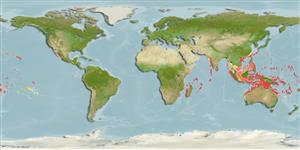Teleostei (teleosts) >
Acanthuriformes (Surgeonfishes) >
Acanthuridae (Surgeonfishes, tangs, unicornfishes) > Nasinae
Etymology: Naso: Latin, nasus = nose (Ref. 45335).
Eponymy: Admiral Cornelis Willemsz de Vlamingh (<1678–1735) was a Dutch explorer and naval officer. [...] (Ref. 128868), visit book page.
More on author: Valenciennes.
Environment: milieu / climate zone / depth range / distribution range
Ecology
Marine; reef-associated; depth range 1 - 50 m (Ref. 9710), usually 1 - 50 m (Ref. 27115). Tropical; 24°C - 28°C (Ref. 27115); 30°N - 30°S, 30°E - 89°W
Indo-pan-Pacific: East Africa to the Galapagos Is. north to southern Japan, south to the southern Great Barrier Reef and New Caledonia, Tuamotus, throughout Micronesia
Size / Weight / Age
Maturity: Lm ? range ? - ? cm
Max length : 60.0 cm TL male/unsexed; (Ref. 3145); max. reported age: 45 years (Ref. 52229)
Dorsal spines (total): 6; Dorsal soft rays (total): 26 - 27; Anal spines: 3; Anal soft rays: 27 - 29. Adults develop a convexly rounded prominent snout and unusually tall dorsal and anal fins. Side of body with vertical blue lines which break up into small blue spots dorsally and ventrally. A broad blue band extending from eye to front of rostral protuberance (Ref 9808).
Occurs in deep lagoon and seaward reefs. Found forming loose schools along upper regions of deep drop-offs (Ref. 48637). Forms mid-water aggregations off steep slopes during the day to feed on zooplankton. Usually found alone or in pairs. Omnivorous. Has the ability to show or hide its blue markings (Ref. 9710). Minimum depth reported taken from Ref. 27115.
Life cycle and mating behavior
Maturity | Reproduction | Spawning | Eggs | Fecundity | Larvae
Myers, R.F., 1991. Micronesian reef fishes. Second Ed. Coral Graphics, Barrigada, Guam. 298 p. (Ref. 1602)
IUCN Red List Status (Ref. 130435: Version 2024-1)
Threat to humans
Harmless
Human uses
Fisheries: minor commercial; aquarium: commercial
Tools
Special reports
Download XML
Internet sources
Estimates based on models
Preferred temperature (Ref.
123201): 25.5 - 29, mean 27.6 °C (based on 684 cells).
Phylogenetic diversity index (Ref.
82804): PD
50 = 0.5000 [Uniqueness, from 0.5 = low to 2.0 = high].
Bayesian length-weight: a=0.03162 (0.01987 - 0.05034), b=2.96 (2.82 - 3.10), in cm total length, based on LWR estimates for this species & Genus-body shape (Ref.
93245).
Trophic level (Ref.
69278): 2.2 ±0.11 se; based on food items.
Generation time: 4.2 ( na - na) years. Estimated as median ln(3)/K based on 1
growth studies.
Resilience (Ref.
120179): Very Low, minimum population doubling time more than 14 years (K=0.264; tmax=45).
Fishing Vulnerability (Ref.
59153): Moderate vulnerability (38 of 100).
Nutrients (Ref.
124155): Calcium = 34.7 [21.4, 64.1] mg/100g; Iron = 0.542 [0.278, 0.926] mg/100g; Protein = 18.7 [17.6, 19.8] %; Omega3 = 0.121 [0.078, 0.223] g/100g; Selenium = 38.2 [20.7, 66.3] μg/100g; VitaminA = 47.4 [15.4, 143.7] μg/100g; Zinc = 1.36 [0.95, 1.93] mg/100g (wet weight);
